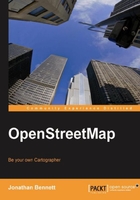
In five years, OpenStreetMap has gone from a small project run by a few enthusiasts in London to being a global resource with thousands of users and the start of an industry based around the data it collects. It's no longer just a hobby for a few, but a serious project attracting the attention of companies and governments.

Many specialist maps have been created, including OpenCycleMap (http://www.opencyclemap.org/) showing cycle networks and routes, a Piste map for skiers and snowboarders, a hiking site combining maps with photos for guidance, and a nautical chart.
When the Beijing 2008 Olympic Games started, the photo-sharing website Flickr (http://www.flickr.com/) began using OpenStreetMap mapping of the city for its users to plot the location of their photos, and has continued to do so.
OpenStreetMap has also made an impact in humanitarian aid. The project has produced mapping of the Gaza Strip in the middle-east (seen in the previous screenshot) through tracing aerial images and information from aid workers in the region. The dangers faced by people working in the region and the rate at which the landscape changes has made up-to-date mapping difficult to obtain. It's hoped that OpenStreetMap's way of producing maps will change this.